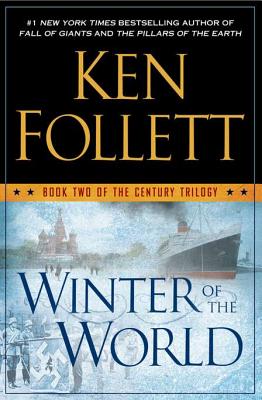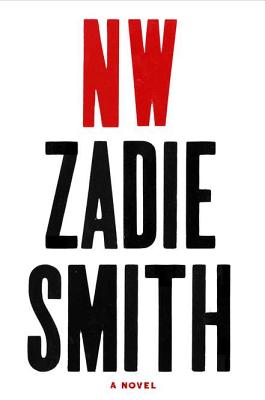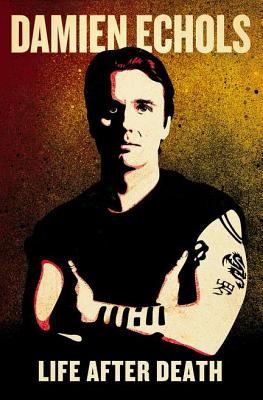Ken Follett follows up his #1 New York Times bestseller Fall of Giants with a brilliant, page-turning epic about the heroism and honor of World War II, and the dawn of the atomic age.
Winter of the World picks up right where the first book left off, as its five interrelated families—American, German, Russian, English, Welsh—enter a time of enormous social, political, and economic turmoil, beginning with the rise of the Third Reich, through the Spanish Civil War and the great dramas of World War II, up to the explosions of the American and Soviet atomic bombs.
Carla von Ulrich, born of German and English parents, finds her life engulfed by the Nazi tide until she commits a deed of great courage and heartbreak. . . . American brothers Woody and Chuck Dewar, each with a secret, take separate paths to momentous events, one in Washington, the other in the bloody jungles of the Pacific. . . . English student Lloyd Williams discovers in the crucible of the Spanish Civil War that he must fight Communism just as hard as Fascism. . . . Daisy Peshkov, a driven American social climber, cares only for popularity and the fast set, until the war transforms her life, not just once but twice, while her cousin Volodya carves out a position in Soviet intelligence that will affect not only this war—but the war to come.
These characters and many others find their lives inextricably entangled as their experiences illuminate the cataclysms that marked the century. From the drawing rooms of the rich to the blood and smoke of battle, their lives intertwine, propelling the reader into dramas of ever-increasing complexity.
As always with Ken Follett, the historical background is brilliantly researched and rendered, the action fast-moving, the characters rich in nuance and emotion. With passion and the hand of a master, he brings us into a world we thought we knew, but now will never seem the same again.
This is the story of a city.
The northwest corner of a city. Here you’ll find guests and hosts, those with power and those without it, people who live somewhere special and others who live nowhere at all. And many people in between.
Every city is like this. Cheek-by-jowl living. Separate worlds.
And then there are the visitations: the rare times a stranger crosses a threshold without permission or warning, causing a disruption in the whole system. Like the April afternoon a woman came to Leah Hanwell’s door, seeking help, disturbing the peace, forcing Leah out of her isolation…
Zadie Smith’s brilliant tragi-comic new novel follows four Londoners - Leah, Natalie, Felix and Nathan – as they try to make adult lives outside of Caldwell, the council estate of their childhood. From private houses to public parks, at work and at play, their London is a complicated place, as beautiful as it is brutal, where the thoroughfares hide the back alleys and taking the high road can sometimes lead you to a dead end.
Depicting the modern urban zone – familiar to town-dwellers everywhere – Zadie Smith’s NW is a quietly devastating novel of encounters, mercurial and vital, like the city itself.
The enchanting story of a midwestern girl who escapes a family tragedy and is remade as a movie star during Hollywood’s golden age.
In 1920, Elsa Emerson, the youngest and blondest of three sisters, is born in idyllic Door County, Wisconsin. Her family owns the Cherry County Playhouse, and more than anything, Elsa relishes appearing onstage, where she soaks up the approval of her father and the embrace of the audience. But when tragedy strikes her family, her acting becomes more than a child¹s game of pretend.
While still in her teens, Elsa marries and flees to Los Angeles. There she is discovered by Irving Green, one of the most powerful executives in Hollywood, who refashions her as a serious, exotic brunette and renames her Laura Lamont. Irving becomes Laura’s great love; she becomes an Academy Award-winning actress—and a genuine movie star. Laura experiences all the glamour and extravagance of the heady pinnacle of stardom in the studio-system era, but ultimately her story is a timeless one of a woman trying to balance career, family, and personal happiness, all while remaining true to herself.
Ambitious and richly imagined, Laura Lamont’s Life in Pictures is as intimate—and as bigger-than-life—as the great films of the golden age of Hollywood. Written with warmth and verve, it confirms Emma Straub’s reputation as one of the most exciting new talents in fiction.
Winter of the World picks up right where the first book left off, as its five interrelated families—American, German, Russian, English, Welsh—enter a time of enormous social, political, and economic turmoil, beginning with the rise of the Third Reich, through the Spanish Civil War and the great dramas of World War II, up to the explosions of the American and Soviet atomic bombs.
Carla von Ulrich, born of German and English parents, finds her life engulfed by the Nazi tide until she commits a deed of great courage and heartbreak. . . . American brothers Woody and Chuck Dewar, each with a secret, take separate paths to momentous events, one in Washington, the other in the bloody jungles of the Pacific. . . . English student Lloyd Williams discovers in the crucible of the Spanish Civil War that he must fight Communism just as hard as Fascism. . . . Daisy Peshkov, a driven American social climber, cares only for popularity and the fast set, until the war transforms her life, not just once but twice, while her cousin Volodya carves out a position in Soviet intelligence that will affect not only this war—but the war to come.
These characters and many others find their lives inextricably entangled as their experiences illuminate the cataclysms that marked the century. From the drawing rooms of the rich to the blood and smoke of battle, their lives intertwine, propelling the reader into dramas of ever-increasing complexity.
As always with Ken Follett, the historical background is brilliantly researched and rendered, the action fast-moving, the characters rich in nuance and emotion. With passion and the hand of a master, he brings us into a world we thought we knew, but now will never seem the same again.
This is the story of a city.
The northwest corner of a city. Here you’ll find guests and hosts, those with power and those without it, people who live somewhere special and others who live nowhere at all. And many people in between.
Every city is like this. Cheek-by-jowl living. Separate worlds.
And then there are the visitations: the rare times a stranger crosses a threshold without permission or warning, causing a disruption in the whole system. Like the April afternoon a woman came to Leah Hanwell’s door, seeking help, disturbing the peace, forcing Leah out of her isolation…
Zadie Smith’s brilliant tragi-comic new novel follows four Londoners - Leah, Natalie, Felix and Nathan – as they try to make adult lives outside of Caldwell, the council estate of their childhood. From private houses to public parks, at work and at play, their London is a complicated place, as beautiful as it is brutal, where the thoroughfares hide the back alleys and taking the high road can sometimes lead you to a dead end.
Depicting the modern urban zone – familiar to town-dwellers everywhere – Zadie Smith’s NW is a quietly devastating novel of encounters, mercurial and vital, like the city itself.
The enchanting story of a midwestern girl who escapes a family tragedy and is remade as a movie star during Hollywood’s golden age.
In 1920, Elsa Emerson, the youngest and blondest of three sisters, is born in idyllic Door County, Wisconsin. Her family owns the Cherry County Playhouse, and more than anything, Elsa relishes appearing onstage, where she soaks up the approval of her father and the embrace of the audience. But when tragedy strikes her family, her acting becomes more than a child¹s game of pretend.
While still in her teens, Elsa marries and flees to Los Angeles. There she is discovered by Irving Green, one of the most powerful executives in Hollywood, who refashions her as a serious, exotic brunette and renames her Laura Lamont. Irving becomes Laura’s great love; she becomes an Academy Award-winning actress—and a genuine movie star. Laura experiences all the glamour and extravagance of the heady pinnacle of stardom in the studio-system era, but ultimately her story is a timeless one of a woman trying to balance career, family, and personal happiness, all while remaining true to herself.
Ambitious and richly imagined, Laura Lamont’s Life in Pictures is as intimate—and as bigger-than-life—as the great films of the golden age of Hollywood. Written with warmth and verve, it confirms Emma Straub’s reputation as one of the most exciting new talents in fiction.
In this magisterial new work The Patriarch,
the celebrated historian David Nasaw tells the full story of Joseph P.
Kennedy, the founder of the twentieth century's most famous political
dynasty. Nasaw—the only biographer granted unrestricted access to the
Joseph P. Kennedy papers in the John F. Kennedy Presidential
Library—tracks Kennedy's astonishing passage from East Boston outsider
to supreme Washington insider. Kennedy's seemingly limitless ambition
drove his career to the pinnacles of success as a banker, World War I
shipyard manager, Hollywood studio head, broker, Wall Street operator,
New Deal presidential adviser, and founding chairman of the Securities
and Exchange Commission. His astounding fall from grace into ignominy
did not come until the years leading up to and following America's entry
into the Second World War, when the antiwar position he took as the
first Irish American ambassador to London made him the subject of White
House ire and popular distaste.
The Patriarch is a story not only of one of the twentieth century's wealthiest and most powerful Americans, but also of the family he raised and the children who completed the journey he had begun. Of the many roles Kennedy held, that of father was most dear to him. The tragedies that befell his family marked his final years with unspeakable suffering.
The Patriarch looks beyond the popularly held portrait of Kennedy to answer the many questions about his life, times, and legacy that have continued to haunt the historical record. Was Joseph P. Kennedy an appeaser and isolationist, an anti-Semite and a Nazi sympathizer, a stock swindler, a bootlegger, and a colleague of mobsters? What was the nature of his relationship with his wife, Rose? Why did he have his daughter Rosemary lobotomized? Why did he oppose the Truman Doctrine, the Marshall Plan, the Korean War, and American assistance to the French in Vietnam? What was his relationship to J. Edgar Hoover and the FBI? Did he push his second son into politics and then buy his elections for him?
In this pioneering biography, Nasaw draws on never-before-published materials from archives on three continents and interviews with Kennedy family members and friends to tell the life story of a man who participated in the major events of his times: the booms and busts, the Depression and the New Deal, two world wars and a cold war, and the birth of the New Frontier. In studying Kennedy's life, we relive with him the history of the American Century.
The Patriarch is a story not only of one of the twentieth century's wealthiest and most powerful Americans, but also of the family he raised and the children who completed the journey he had begun. Of the many roles Kennedy held, that of father was most dear to him. The tragedies that befell his family marked his final years with unspeakable suffering.
The Patriarch looks beyond the popularly held portrait of Kennedy to answer the many questions about his life, times, and legacy that have continued to haunt the historical record. Was Joseph P. Kennedy an appeaser and isolationist, an anti-Semite and a Nazi sympathizer, a stock swindler, a bootlegger, and a colleague of mobsters? What was the nature of his relationship with his wife, Rose? Why did he have his daughter Rosemary lobotomized? Why did he oppose the Truman Doctrine, the Marshall Plan, the Korean War, and American assistance to the French in Vietnam? What was his relationship to J. Edgar Hoover and the FBI? Did he push his second son into politics and then buy his elections for him?
In this pioneering biography, Nasaw draws on never-before-published materials from archives on three continents and interviews with Kennedy family members and friends to tell the life story of a man who participated in the major events of his times: the booms and busts, the Depression and the New Deal, two world wars and a cold war, and the birth of the New Frontier. In studying Kennedy's life, we relive with him the history of the American Century.
In 1993, teenagers Damien Echols, Jason
Baldwin, and Jessie Misskelley, Jr.—who have come to be known as the
West Memphis Three—were arrested for the murders of three eight-year-old
boys in Arkansas. The ensuing trial was marked by tampered evidence,
false testimony, and public hysteria. Baldwin and Misskelley were
sentenced to life in prison; while eighteen-year-old Echols, deemed the
“ringleader,” was sentenced to death. Over the next two decades, the WM3
became known worldwide as a symbol of wrongful conviction and
imprisonment, with thousands of supporters and many notable celebrities
who called for a new trial. In a shocking turn of events, all three men
were released in August 2011.
Now Echols shares his story in full—from abuse by prison guards and wardens, to portraits of fellow inmates and deplorable living conditions, to the incredible reserves of patience, spirituality, and perseverance that kept him alive and sane while incarcerated for nearly two decades.
In these pages, Echols reveals himself a brilliant writer, infusing his narrative with tragedy and irony in equal measure: he describes the terrors he experienced every day and his outrage toward the American justice system, and offers a firsthand account of living on Death Row in heartbreaking, agonizing detail. Life After Death is destined to be a riveting, explosive classic of prison literature.
Nate Silver built an innovative system for predicting baseball performance, predicted the 2008 election within a hair’s breadth, and became a national sensation as a blogger—all by the time he was thirty. The New York Times now publishes FiveThirtyEight.com, where Silver is one of the nation’s most influential political forecasters.
Drawing on his own groundbreaking work, Silver examines the world of prediction, investigating how we can distinguish a true signal from a universe of noisy data. Most predictions fail, often at great cost to society, because most of us have a poor understanding of probability and uncertainty. Both experts and laypeople mistake more confident predictions for more accurate ones. But overconfidence is often the reason for failure. If our appreciation of uncertainty improves, our predictions can get better too. This is the “prediction paradox”: The more humility we have about our ability to make predictions, the more successful we can be in planning for the future.
In keeping with his own aim to seek truth from data, Silver visits the most successful forecasters in a range of areas, from hurricanes to baseball, from the poker table to the stock market, from Capitol Hill to the NBA. He explains and evaluates how these forecasters think and what bonds they share. What lies behind their success? Are they good—or just lucky? What patterns have they unraveled? And are their forecasts really right? He explores unanticipated commonalities and exposes unexpected juxtapositions. And sometimes, it is not so much how good a prediction is in an absolute sense that matters but how good it is relative to the competition. In other cases, prediction is still a very rudimentary—and dangerous—science.
Silver observes that the most accurate forecasters tend to have a superior command of probability, and they tend to be both humble and hardworking. They distinguish the predictable from the unpredictable, and they notice a thousand little details that lead them closer to the truth. Because of their appreciation of probability, they can distinguish the signal from the noise.
With everything from the health of the global economy to our ability to fight terrorism dependent on the quality of our predictions, Nate Silver’s insights are an essential read.
Now Echols shares his story in full—from abuse by prison guards and wardens, to portraits of fellow inmates and deplorable living conditions, to the incredible reserves of patience, spirituality, and perseverance that kept him alive and sane while incarcerated for nearly two decades.
In these pages, Echols reveals himself a brilliant writer, infusing his narrative with tragedy and irony in equal measure: he describes the terrors he experienced every day and his outrage toward the American justice system, and offers a firsthand account of living on Death Row in heartbreaking, agonizing detail. Life After Death is destined to be a riveting, explosive classic of prison literature.
Nate Silver built an innovative system for predicting baseball performance, predicted the 2008 election within a hair’s breadth, and became a national sensation as a blogger—all by the time he was thirty. The New York Times now publishes FiveThirtyEight.com, where Silver is one of the nation’s most influential political forecasters.
Drawing on his own groundbreaking work, Silver examines the world of prediction, investigating how we can distinguish a true signal from a universe of noisy data. Most predictions fail, often at great cost to society, because most of us have a poor understanding of probability and uncertainty. Both experts and laypeople mistake more confident predictions for more accurate ones. But overconfidence is often the reason for failure. If our appreciation of uncertainty improves, our predictions can get better too. This is the “prediction paradox”: The more humility we have about our ability to make predictions, the more successful we can be in planning for the future.
In keeping with his own aim to seek truth from data, Silver visits the most successful forecasters in a range of areas, from hurricanes to baseball, from the poker table to the stock market, from Capitol Hill to the NBA. He explains and evaluates how these forecasters think and what bonds they share. What lies behind their success? Are they good—or just lucky? What patterns have they unraveled? And are their forecasts really right? He explores unanticipated commonalities and exposes unexpected juxtapositions. And sometimes, it is not so much how good a prediction is in an absolute sense that matters but how good it is relative to the competition. In other cases, prediction is still a very rudimentary—and dangerous—science.
Silver observes that the most accurate forecasters tend to have a superior command of probability, and they tend to be both humble and hardworking. They distinguish the predictable from the unpredictable, and they notice a thousand little details that lead them closer to the truth. Because of their appreciation of probability, they can distinguish the signal from the noise.
With everything from the health of the global economy to our ability to fight terrorism dependent on the quality of our predictions, Nate Silver’s insights are an essential read.






No comments:
Post a Comment